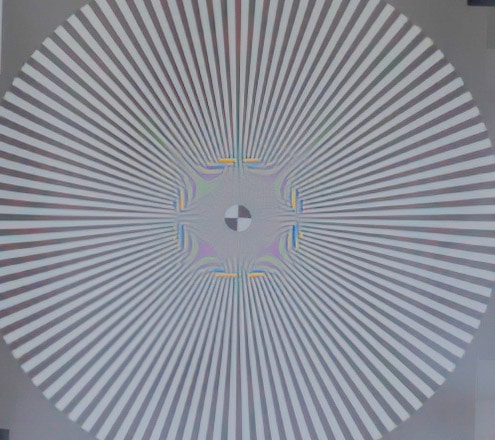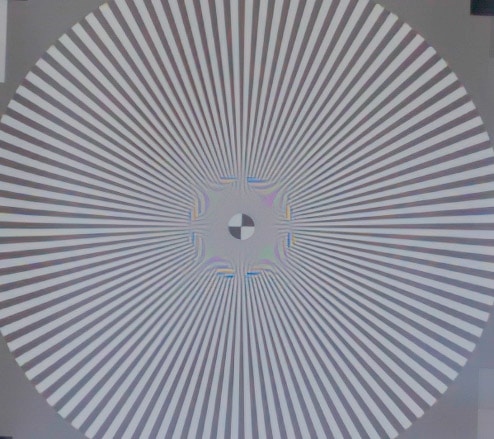This is one in a series of posts on the Sony alpha 7 R Mark IV (aka a7RIV). You should be able to find all the posts about that camera in the Category List on the right sidebar, below the Articles widget. There’s a drop-down menu there that you can use to get to all the posts in this series; just look for “A7RIV”.
In the last two posts I’ve looked at the relative resolution of the a7RIII and a7RIV, and found the a7RIV, as I expected, to have greater resolution than the earlier camera. At the risk of introducing a confounding variable, I decided to see what happened when the images from the two cameras were upsized using GigaPixel AI, which is more likely to be used for large prints than the Lightroom export upsizing algorithms I used before. I just worked with the f/2.8 images, and upsized the ones from both cameras to close to the same dimensions:
The timings are included in the right column; more on them later.
Here are 1:1 crops from the upsized images:


Resolution can be measured by the diameter of the “event horizon” where coming from the outside in, the spokes begin to diverge due to aliasing. It is higher for the a7RIV, since the diameter of the circle where divergence begins is smaller.
Aliasing appears to be slightly less prevalent on the a7RIV, probably because the limitations of the lens play a roll. These images came from feeding the .ARW files directly to GigaPixel AI.
Notes on GigaPixel AI performance
There have been complaints of GigaPixel AI taking more than half an hour to upsize a7RIV images to slightly larger than the size that I chose. If you look at the timings above, you can see that my measurements were substantially faster. I did use the GPU acceleration, though:
When I turned off the GPU acceleration, my times were about 50% longer.
There have also been reports of freezes of GigaPixel AI when using GPU acceleration and slow response of other software when GigaPixel AI is running. I experienced no such problems.
I did find that GigaPixel AI used almost all of the 3D GPU cycles:
It also used some CPU resources:
Different systems will have different results. You can see the CPUs in my system and the GPU that I used in the two screen shots above.
Very interesting and valuable tests of the new a7RIV. While I had some expectations, it appears the improvements in image quality are marginal at best, and going by what I have seen over at Frank Lloyd’s blog, diffraction and field curvature pose significant limitations to what can be achieved even with the best native E-mount optics available.
I guess the wisest course of action to follow is to simply stick to your a7RIII, if you already own one, or get one now that they are selling for $700 USD less. Getting one as back-up now that they are cheaper appears to be the best advantage brought by the a7RIV.
The temptation of the EVF – larger grip and new buttons – as potential improvement on overall shooting experience, is still easily averted by the fact that image quality improvement isn’t there, and that having invested in the best optics, isn’t a ticket to improvement either.
Is it possible that the a7RIII is the sweet spot for image quality for money on the Sony platform, and the best option to get the most out of the best native E-mount optics, or can the a7RIV see some firmware improvements that might make it worth the price?
Thank you for your generous effort, curiosity and entertaining writing.
Cheers!
PS: I think I might have done something wrong submitting this comment/question the first time over, as I saw the “Pending Moderation” notification appear when i submitted my previous question in this regard.
Don’t worry. I review all the posts here prior to their going live.
Making the sensor higher resolution will not make any of those things more damaging to an image at the same print size.
I see, I was trying to follow what I understood from Lloyd’s reasoning – and that alone doesn’t make it accurate, of course – in the sense that the higher resolving sensor amplifies field curvature and is less forgiving in this respect, and that diffraction kicks in earlier. It suggests that a higher resolving sensor makes it harder to get the best results possible, even with the very best optics.
The higher resolution sensor doesn’t make field curvature any worse. It just provides higher resolution in the areas of the image where the lens can lay down high spatial frequency information that the finer pitch sensor can resolve and the corasere one can’t.
When measured in same-sized prints, diffraction does not kick in any sooner with a high-resolution sensor than it does with a lower-res one.
With the Sony 3.76 um sensors, like the one used in the a7RIV and the one used in the GFX 100, you have to stop down to f/16 before the lens is the limiting factor wrt resolution.
This is completely bassackwards. With the same lens and scene, the higher resolution sensor will never give worse results than the lower resolution one. With the very best optics, the differences will be even greater.
The A7riv has other advantages over the a7RIII than the small increase in resolution. The ergonomics are better, the AF is better, etc.
Yes, I completely agree on the EVF and ergonomics, and I have to admit I was seeing it from my own very limited perspective. I shoot manual lenses only, so I wasn’t counting AF improvement as such.
Manual focusing is easier.
To get the most out of the best E-mount optics on the lens axis is going to take at least 800 megapixels.
Yes, the math certainly suggests something in that order; my assumption – perhaps too simplistic – was that of a situation of diminishing returns, in which higher resolution meant certain limitations and artifacts – as those mentioned – which would also be amplified or incremented by it, and thus limit its ultimate benefit, or at least not allow for it to be linear, let alone be justify the cost of upgrading.
As a rough rule of thumb, the diameter of the combined circle of confusion is the square root of the sum of the squares of the CoCs due to diffraction, lens aberrations, defocus, and sensor aperture. If you do the math, be sure to use the encircled energy formulation of the Airy disk; if you take the diameter as the distance from the first minimum to the first minimum on the other side, that’s too pessimistic.
https://blog.kasson.com/the-last-word/blur-circle-size-estimation-with-encircled-energy/